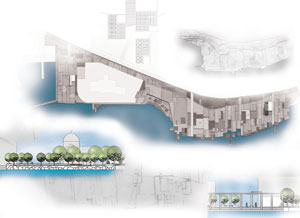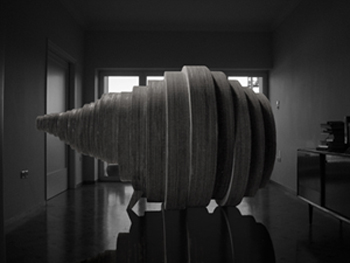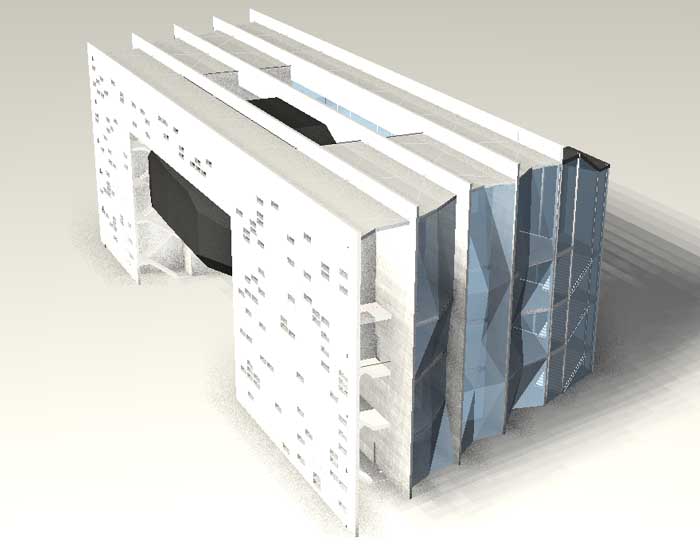

The topic of the dissertation for bachelor’s degree is concerned with the planning of premises for the needs of the “Hospitality Home of minors, and Youth Centre” in the area of Nea Ionia, Volos. The main concern is the creation of places to accommodate structures and services, which will serve as a substitute for family and as preparation for their placement in the community.
It concerns children of the Prefecture of Magnesia of the age of 6-18 years, mainly girls, whereas, in case of brothers and sisters, there is no separation of sexes. The program includes a hall of residence, classrooms, rooms for laboratories, expositions, voluntary programs and support of parents and family.
The plot of land, which is studied, lies in the developing area of Kserokampos in Nea Ionia, Volos, near the exit to Ring Road.
The planning is very clear and follows the general architectural “neatness” and strictness, which are the characteristics of the area. Volumes of buildings, perpendicular to each other, are met at the north-east side of the plot, separating the “square” from the two central roads, and leave it open to the small street and the school.
The placement of the buildings was determined a) by the dynamics of the roads which include the plot of land, which is being planned for building, b) by the uses of the opposite buildings and c) by the orientation of the plot of land.
The volumes of buildings are developed at three levels in the plot and their interior hides different services, thing that justifies the occupation of space of each volume in the composition.
A compact plate that seems to float in the air, includes in its interior the services of the Hospitality Home of Minors, whereas its holed “epidermis” creates games of shading and of light in the internal as well as the external spaces, giving the minor a sense of protection, because it functions as a filter against undesired glances coming from the external environment. The services are divided into three zones: the “zone of the night”, the “zone of the day” and the “zone of auxiliary spaces”.
An intermediate floor, connecting the “open with the closed”, can function as a courtyard for the children of the program.
Supervisor: Manolidis Kostas
Reference Number: 382


The purpose of this project is to redesign the part of the seafront of the area of Volos that ranges from St. Konstantin Church to Anavros Park. Based on the results derived from this project, the area that collects the most negative reviews is Anavros Park. Having knowledge of the problems and the historic evolution of the area, we are putting forward a new suggestion adopting a more modern view, and in the same time, we are maintaining an imaginary connection with the past. The goal is to integrate Anavros Park to the rest of the seafront and to strongly connect it with the area, and in addition, to ensure the accessibility and visitation to the place during the whole year. The source of inspiration for the conformation of this area is the pre - earthquake city of Volos and the original cause for which this soil was created, that is being filled with materials from the residences that were demolished by the earthquake.
Supervisor: Manolidis Kostas
Reference Number: 409


L'Endormeuse is an attempt to investigate the relations between reality/fantasy, subject /object, active/passive, private/public and suggests a hybrid environment, a room-machine of an hypnotic experience which comprises out of three elements: the rotorelief ( the sleeping machine), the “tub” ( the sleeping space) and the bed.
The design of this installation-room began with the transformation of Marcel Duchamp’s’ hypnotic disk “Chinese Lantern”, one of the Rotoreliefs, in three dimensions creating the spacial dimension of the geometric motif of the disk.
The geometry of the Rotoreliefs is based on eccentric circles slightly misplaced, which produce a warp and the illusion of a three dimensional space when they turn with the help of a motor at a steady rhythm. The beating rotating movement of the rotoreliefs is related with the throwing of the pottery maker and from the Anemic Cinema by Duchamp we are transferred conceptually at the tub of Diogenes in which he slept. L’Endormeuse is an attempt to redefine this constitution and to point out their relation in spatial dimensions.
The logic of the eccentric circles is also transfused at the design of the sleeping space, the “tub”, which is the steady part of the construction. A cavity is created, a type of grotto, grooved on the inside as an optical continuity of the rotating part of the construction, into which the bed is adjusted in a way so that the gaze can be focused at the rotating rotorelief.
This is about an installation, a kind of experimental sleeping-room that exists as an isolation space in which the user is behaving passively and is subjected by the room itself in the sleeping routine. L’Endormeuse being a machine acts as a “conductor” between consciousness and the state of sleep and under certain conditions can lead to the hypnopompic and hypnagogic experiences. It would be characterized as a container of accumulation of the space of sleep as a dimension and as an experience.
Supervisors: Antonas Aristide, Tzirtzilakis Yorgos
Reference Number: 380


The proposal of this thesis lies in the mountain of Penteli. From ancient times until today, marble quarries operated in various locations. Today, the only active quarry is located in Dionysus. Initially, mining was done through outdoor exploitation, while in 1993 was implemented the cutting of the underground quarries.
The gradual removal of marble blocks, created inside the mountain empty cavities consisting of galleries and chambers. Specifically, two underground exploitations are identified. The proposal focuses on filling the empty cavity of the second exploitation, by creating infrastructure for receiving and processing analog printed material (books, newspapers, magazines, maps, etc.) for the conversion to digital, digital storage and archiving of material, which coexists with areas accessible to the public for the realization of a multitude of activities. We deem that mining activities in the second vault stop at this exact moment, while in the outdoor exploitation continue operating normally.
Regarding the first vault, marble mining has depleted due to discontinuities in its texture. The vault is left empty, however, making all the available levels accessible, allows the visitor to wander in as they wish. In addition, it is possible to accommodate temporary or (more) permanent uses such as festivals, theatrical performances, exhibitions.
The need to protect and maintain the information was always present, in order to ensure access not only in the present but also the future. Based on the archetype of the cave as a crypt, which is considered a safe place to store anything precious, even sacred, led us to the installation of the digital file in the vaults of the quarry. The process of marble extraction, that is the disclosure of the material, created the holes for the reception of the new "material", the accumulation of information, which are expecting their new extraction.
Supervisors: Antonas Aristide, Manidaki Eva
Reference Number: 373


The minimum requirements of water needed for a person to survive can be as low as 20 lt per day. This thesis attempts to design the infrastructure of a settlement based on this statement.
The core structure designed is a water tower containing systems for rainwater harvesting and water treatment. The water is distributed to every part of the settlement through smaller infrastructure parts. Around this center defined by the water tower, the settlement slowly develops, through random concentration of residents, temporary or permanent.
People often have to move in order to adapt to change, either environmental, social or economic. A solid structure, such as the infrastructure designed, rooted in a place is a key element to the dynamics of people's mobility.
However due to the global scale of the mobility phenomenon, as well as the characteristics of every environment, require more flexible forms, able to cover the needs of the people.
The case study refers to a community already settled in a region of Chad, Africa, where there are currently over 30.000 poorly living refugees. The proposed settlement includes all sorts of infrastructure as well as housing and agricultural regions for a group of 1000 people. This new part of the settlement attempts to solve many of the issues the refugees have to face, with emphasis to the availability and distribution of fresh water. Other traditional techniques related to building, shading and cooling are also incorporated to the infrastructure.
An infrastructure is a promise for future activities. It is a reason for people to settle in a region and transform it into something bigger and more permanent. The multifunctional center concentrates the communal activities and reinforces the social relationships of the residing population. The goal is to create possibilities of an autonomous community that will gradually evolve and adapt.
http://theadaptationproject.tumblr.com/
Supervisors: Gavrilou Evelyn, Lykourioti Iris
Reference Number: 404


The relationship of the city of Volos with music, is confirmed by the creation of the "Philharmonic Orchestra" in 1920 but has never had a permanent home. The aim of this thesis is to create a building to house this band and to be an urban reference. Also coming in dialogue with the sea and the city of Volos, seeking a broader contact between them, it aims to enhance its presence in this institution and the integration of music in the city life.
Supervisor: Paniyiris Costis
Reference Number: 392


The theme of this thesis was to design a space for hosting workshops, groups such as students or volunteers. . The plot is situated in the traditional village Maroulas, in Rethymno, Crete.
The settlement of Maroulas is a typical example of a traditional Cretan village and is clearly an evidence of the traditional Cretan architecture. Buildings reflect the history and the influences accepted by cultures of the conquerors of the island, adapted to local tradition.
Initially, the traditional folk architecture and the components that shape it were studied, as well as the influences received, and typologies of Cretan folk house were recognised. There was an investigation of the materials used, the waythat the materials were supplied, as also the way that they were building the houses.
Then, there was an investigation into the settlement, about the history, the geographical and morphological characteristics and what are the specific elements of it’s character.
The purpose of this study was to respect the natural landscape and history of the settlement, to make the proposal fit well in it. This does not mean simply copying the traditional methods and techniques, but the selection of elements of folk architecture that were interesting, to join the new building, through new design proposals. The data was drawn from the traditional architecture, was the simplicity of construction, the purity of the tumor, the response of the floor plan on the functionality of the spaces. Tumors are placed in such a way as to create interesting new levels and useful sites.
In light of these features were designed private units accommodating the needs of visitors along with common areas for their congregations. The meaning of thecourtyard in designing was very important also.
The materials selected are local, ie stone and wood. The skeleton of the building is made of concrete.
Generally, the target of this guesthouse is designed to join smoothly the settlement, and respect the history of the original and traditional buildings of the village, seeking to link with the past.
Supervisors: Kanarelis Theoklis, Philippitzis Dimitris
Reference Number: 376

